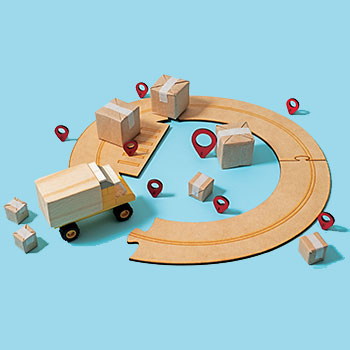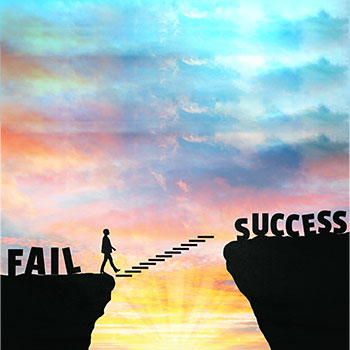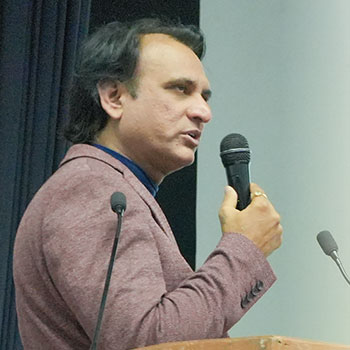Powering Supply Chain Operations

Vinod Bhatt, senior director and head of supply chain operations – Greater Asia and India, Hewlett-Packard (HP) is a highly accomplished professional having 25 years of experience and expertise in supply chain management sector across various hi-tech industries – consumer electronics, FMCG and telecommunication. His fields of expertise include executive leadership,transitional coaching, strategic planning and execution, and digital supply chain with a focus on automation robotics, people development and team effectiveness. Corporate Citizen brings to you the excerpts of his talk wherein he speaks about his early life, corporate journey, life learnings and more
Early life
I belong to Dehradun in Uttarakhand and passed out doing B.Com in 1992. After which I completed my MBA from University of Mumbai in 1994. I hail from a middle class family and feel fortunate as a lot of values get ingrained in yourself through it. My father worked in Godrej plant in Mumbai. due to which I spent my entire childhood there. It had a big school, big campus and a whole housing society for employees there. A lot of my school friends and colleagues ended up joining Godrej because their fathers worked in the company. So I thought it was the easiest pathway to start my career as well.
First big life lesson
My father gave me the first big life lesson as he told me, "You can’t come to me and say you want to join Godrej, please talk to someone and use some influence". I was disappointed, so I took efforts to reach out to my network of friends and colleagues and I got a job in Hindustan Unilever, which was then known as Hindustan Lever. It is a breeding ground for future managers and leaders. Lot of its executives and leaders are doing wonders globally. Looking back—I had a knack for accepting challenges, doing things differently, taking risks. Hindustan Lever’s job was a stable job and down the line, I would have grown into a middle-rung level. But, I started looking for opportunities elsewhere, which was not out of frustration.
Catching opportunities
The reason I switched from a giant company like Hindustan Unilever to a small company, JL Morison (India) Ltd, that sold Nivea brand products, was because I got the opportunity to work as a manager. When you start your career at young age you feel that there must be people reporting to you. It’s not about the glamour of being a manager, it’s about leading the team and how you mentor them. Later, I proceeded to join LG India which was not well-known at that time in India, in 1995-97—a multinational South Korean company in electronics and white goods sector.
The LG company entered India and started hiring people, more like a walk-in interview. I walked into a big hotel in Mumbai and had flash interview by the HR person, who was my potential GM and a Korean. They interviewed me on May 10 and wanted me to start working on May 15. I was going to get married soon so needed holidays but they were adamant and were about to snatch the appointment letter. In order to not lose the opportunity, I accepted the offer and joined the company.
The government opened telecom industry to private players in late 1990s due to which many foreign players came in, had tie-ups with Indian companies and started getting licenses to operate telephone services. I continued to get managerial work but it was more of driving projects—how we get involved in projects, how we do end-to-end based projects. I was technically running operations but it was more of logistics and supply chain, and this terminology was brought in by MNCs as these names were not heard then in Indian company setups.
I continued to work in telecom sector and I joined Nortel Networks, one of the best companies that had a great environment and culture. It was a high pressure job. We worked for some of the most difficult customers on the planet. Just to give you a feel of challenges we faced — we had to deploy Code Division Multiple Access network for Reliance (with due respect to Mr. Ambani) it is one of the most difficult customer on the planet. It was very tough—they wanted us to deploy the project in six months, which any telecom company would take around 18 months. So you can imagine what the pressure was at that time and we took it as a challenge. These were great learnings for me when I started my career.
"Peaks and valleys are connected and inter-related. The errors that you make in today’s good time create tomorrow’s bad time"
-Vinod Bhatt
Journey in HP

Eventually I joined HP which volunteered to relocate me to Delhi. We should be always receptive to changes. Mumbai was a comfort zone for me as I did my schooling, started my career and did everything there. Back in Delhi we always say that Mumbai folks can’t adjust in Delhi and vice versa. That is one of the life learnings that I would take back.
I spent a lot of time in HP, and was primarily in the logistics and supply chain operations role in Delhi. HP is a huge company and had verticals of PC division, printer division, enterprise division and others. Lot of mergers happened within the divisions and we had a separation as well. So I ended up doing lot of expanded roles and integrated roles. The personal system (PS) division is nothing but the PC division and enterprise division, then we had the integration of the print and PS division. I was fortunate to have the entire role of operations there. Then customs, compliances, trade and all this added to my kitty. As you move ahead you fight challenges and conquer new territories. This is a new learning—how you keep on challenging yourself and take expanded roles.
HP prepared a big enterprise resource planning (ERP) in the system in 2018. We had a dozen systems across the board which eventually they integrated into a single system. It was a very big project. OTC system was like Order To Cash, so I was a sponsor for that work stream. It gave me an opportunity to think beyond operations in strategy, tactical and all that. After which I got elevated to run the supply chain operations.
India had become a big market within the global set-up. Normally big global companies have three regions – Asia Pacific, Americas and Europe. The management marked key markets across the globe. India was one of those because it is a big promising market. I was running a supply chain there. The last role that I took a few months back is of running customer operations which I feel is end-to-end. We can say in management parleys that everything starts with a customer and ends with a customer—from the time the order comes in until we execute the fulfillment of the order or we do cash collection. This has been my journey all across. Now I am doing mentoring and coaching. It’s a two-way traffic, when you mentor and coach, you learn a lot.
"You can have fewer bad times when you appreciate and manage your good times wisely. You have to be prepared to stay longer on the peak"
Sustainability in HP

We ship around 100+ PCs, around 90 printers, around 1000 ink and toner cartridges, per second. Daily we ship 540 TEUs (twenty foot equivalent units), more than 2,000 tonnes of goods. We have a massive global network of 34 distribution centres, 69 manufacturing locations and 169 destination countries. So the responsibility of big companies on sustainability is more.
When we talk of sustainability we think it is all about carbon footprint, going green, how do we drive deforestation and others. It’s a deeper topic. Sustainability comprises of three parts – Planet (climate action), People (human rights) and Community (digital equity). Climate action consists of carbon emissions and forests. On the people side of things, we have human rights where we talk of diversity, equity and inclusion (how we get all people together with us). On the community side, it is digital equity. These are the pillars of sustainability.
I think HP and lot of other big companies are great examples of how we are on the right path. On the climate side the whole objective is to drive a zero carbon footprint which means that our products should be designed in such a way that the carbon emissions are negligible. HP has set a goal of how to go zero carbon in next 5 or 10 years? The products of companies like HP are designed in such a way that they have a trademark of sustainability.
On the people side it is diversity, equity and inclusion. We want gender equality in corporates. Digital equity is in the DNA of HP—the products and services we offer in the market. There is a big potential for growth in India. It is where the big companies like HP play a big role in ensuring how we have the outreach to the last villages. That is where HP, on the sustainability factor does a great job. More than just good business, HP is pioneering responsible tech with revolutionary devices, helping to protect and restore forests with expert NGO partners, creating economic opportunities while keeping plastic out of the ocean, and increasing circularity and reimagining smart logistics.
"A great way to get to your next peak is to follow your sensible vision. Imagine yourself enjoying a better future in such specific and believable detail that you soon enjoy doing what takes you there"
Circularity

Since 2017, HP has launched 300+ new products around the world containing ocean bound plastic. Around 13 per cent of post-consumer recycled plastic is used in our products and more than 1200 tonnes of ocean bound plastic used since 2016. There was a reduction of usage of 44 per cent in single use plastic in our packaging from 2016 to 2019, compared with a 19 per cent reduction in 2020. The goal is to have 100 per cent reduction in single plastic use in next five years. Around 3,89,000 tonnes of hardware reused or recycled and supplies recycled. This is all about use, recycle and reuse of materials so that the material can be brought back in the lifestyle structure.
The sustainable pitching of products adds to the topline and bottom line of companies. HP garnered new sales wins of US 3.5 billion dollars in 2022 due to the sustainable pitch. Lot of companies and global customers want sustainable products. Nearly $1 billion of net proceeds from HP’s inaugural Sustainability Bond have been allocated to eligible products. HP tracked over $7 billion in new sales in which it met customer requirements for registered product eco-labels, including ENERGY STAR, EPEAT and Blue Angel. HP partners have completed more than 10,000 sustainability training courses.
Have you ever wondered why ‘age’ is considered ‘wise’? Because as you age, you bridge the distance between two peaks more easily. Age here does not refer to actual human years but the mental age.
Everyone goes through peaks and valleys. How you view the valley determines how you will scale the peak? Peak is nothing but it is where you reach your success, you are happy, you are content while valley denotes despair, frustrations and failures.
Peaks and Valleys story
A young man set out on a journey to escape the valley and climb a new peak. On the peak, he met an old man who changed the way he viewed the valleys and the peaks. He was actually running from something and not really happy with his career, professional life and personal life. He had a sense of not living up to his potential. The old man he met at the peak made him see what was there all along. That’s where he got a clear insight about this.
Lessons from the story
Lesson 1: Peaks and valleys are not just the good and bad things that happen to you. They also reflect how you feel and how you reflect it back into the system. So here, your perception and perspective are important.
Lesson 2: Peaks and valleys are connected and inter-related. The errors that you make in today’s good time create tomorrow’s bad time.
Lesson 3: There should be work-life balance. You should introspect especially when you are in a valley, about how you can go to a peak. Avoid comparisons to have fewer valleys.
Lesson 4: You change a valley into a peak when you find and use a good that is hidden in a bad time. The path out of the valley appears when you choose to see things differently. Choosing a better belief leads to better results.
Lesson 5: Between peaks there are always valleys. How you manage your valley will determine how soon you will reach your next peak. If you do not learn in a valley you can become bitter.
Lesson 6: You can have fewer bad times when you appreciate and manage your good times wisely. You have to be prepared to stay longer on the peak.
Lesson 7: How do you fall from a peak? Ego. Your ego distorts the truth. On a peak your ego makes you see things better than they really are. You are in an illusionary world. When you are in a valley, your ego makes you see things worse than they really are.
Lesson 8: The most common reason you leave a peak too soon is your arrogance, masking as confidence. The most common reason you stay in a valley too long is fear masking as comfort. One has to learn to see the truth in a situation.
Lesson 9: A great way to get to your next peak is to follow your sensible vision. Imagine yourself enjoying a better future in such specific and believable detail that you soon enjoy doing what takes you there. When you believe in it. You achieve it.
Lesson 10: The pain in a valley can wake you up to a truth you have been ignoring. Your valley is fear. If you move beyond your fear you can create value and soon feel better. Avoid believing that things are better than they really are when you are on a peak, and worse than they really are in a valley. Make reality your friend.